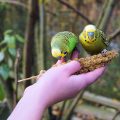Although it is recommended that owners learn their birds’ “language” and coo back at them in the name of companionship, it will soon be quiet clear to you that your dove regards you as rather slow in the communication department!
In order to get your attention so you can resolve whatever is bothering the bird, your doves may resort to a level of communication they think you are more suited to understand. For instance, a dove trying to get his point across:
- bang around in the cage
- flap from perch to perch
- rattle his seed cup
- do anything else to be noisy and noticeable
This may be the dove’s way of saying he’s hungry, his water needs changing, he wants more nesting material, or he’s feeling neglected.
People often say they wish their pets could speak English because it would be so much easier to know exactly what the animal wants or needs instead of trying to guess. Imagine the dove’s frustration! There he is, “speaking” perfectly coherent “dove” to a thickheaded human who is just not getting the message!
Remember that all doves are individuals and each one will have a unique vocabulary. That being said, these are some of the sounds you are most likely to hear.
- Bow and Coo – This is a combination action and sound. The dove bows deep and coos either to signal that another dove is trespassing on his territory or as an enticement to a female at breeding. The action may be preceded by a “laugh.”
- Laugh – A chuckling sound that can be a territorial warning, an acknowledgement of successful mating, or a greeting upon returning to the perch. (Some enthusiasts refer to the “return” sound as a soft “giggle.”)
- Surrender – A sound very like a whine that is an indication of non-hostile surrender, as in establishing a friendship. It can also be used by a mother dove to call her young, or as a signal of approaching danger.
- Bark – An indignant sound that expresses displeasure or dislike accompanied by a very disgusted expression, usually with the dove looking down its beak.
- Scolding – Used by female doves in a protective mode either for their home or nest and especially when guarding eggs or babies. A series of squeals with whistling and huffing.
- Territorial Coos – This is a male behavior that most often occurs at sunrise and sunset and can go on for an extended period of time. A male generally stands at a 45-degree angle while cooing, with the throat area ballooning outward. This is a signal of ownership and will especially be displayed when other males are near.
- Twitter – A kind of chattering sound not unlike that made by a chipmunk. It is generally a vocalization made as a warning or when the bird is straining, for instance if the animal is constipated.
Very young doves also peep, which can best be described as a long series of short, fast, high-pitched vocalizations, often to indicate distress. This may signal anxiety over locating the parent or signal that the baby is hungery.






 Author and long-time animal lover. Sharing knowledge on pet care through experience and the written word.
Author and long-time animal lover. Sharing knowledge on pet care through experience and the written word.